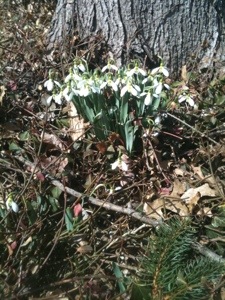
We have had a few sneak previews of Spring weather over the last couple of weeks, but Winter seems to refuse to give up. Even though we seem to be stuck in this up and down trend we have picked up some growing degree days in the Greater Cincinnati area. As of this writing on March 14, 2014 we have accumulated 37 degree days so far. I guess an explanation of growing degree days would help, this is the definition given by OSU OARDC and Extension.
Growing Degree Days are a measurement of the growth and development of plants and insects during the growing season. Development does not occur at this time unless the temperature is above a minimum threshold value (base temperature). The base temperature varies for different organisms. It is determined through research and experimentation. The actual temperature experienced by an organism is influenced by several factors. These factors affect growth and development. For instance, depending on the weather, an organism’s temperature may be a few degrees more or less than that recorded. An organism may spend its time in the shade or under direct sunlight. The fertility and nutrient content of the soil directly affect the growth rate of insects and plants. The presence of weeds and precipitation may indirectly influence development. Due to these factors and some other scientific considerations, a base temperature of 50 degrees Fahrenheit is considered acceptable for all plants and insects.
Here is what to expect in the upcoming several weeks from 37 to 100 growing degree days as we accumulate them.
Species Event GDD
Corneliancherry Dogwood first bloom 40
Silver Maple full bloom 42
Red Maple first bloom 44
Speckled Alder first bloom 52
Northern Lights Forsythia first bloom 58
Red Maple full bloom 75
Star Magnolia first bloom 83
White Pine Weevil adult emergence 84
Border Forsythia first bloom 86
Eastern Tent Caterpillar egg hatch 92
Manchu Cherry first bloom 93
Northern Lights Forsythia full bloom 94
Speckled Alder full bloom 97
Corneliancherry Dogwood full bloom 98
I’m hoping to have to post an update real soon as the degree days add up.
~ Michael
38.998950
-84.626611










 We have been blessed with some nice weather this afternoon so my wife and I decided to get out in the yard for a while and clean up some of the flower beds around the house and down by the street. I must say that it feels really good to feel the warmth of the sun once again, it’s kind of like an old friend you haven’t seen for a while. Getting down on my knees and working in the flower beds is like an old familiar place that I was happy to reconnect with. Here in Northern Kentucky we are considered a USDA Zone 6, and are seeing Early Spring flowers emerging from the ground as the soil begins to warm. Many of us are starting to get that Spring itch, especially after a more active than normal Winter. That got me to thinking about what I was doing, and what was best for the plants and having a really nice Spring show this year. So I’d like to leave you with a few thoughts before you begin your Spring clean up jobs.
We have been blessed with some nice weather this afternoon so my wife and I decided to get out in the yard for a while and clean up some of the flower beds around the house and down by the street. I must say that it feels really good to feel the warmth of the sun once again, it’s kind of like an old friend you haven’t seen for a while. Getting down on my knees and working in the flower beds is like an old familiar place that I was happy to reconnect with. Here in Northern Kentucky we are considered a USDA Zone 6, and are seeing Early Spring flowers emerging from the ground as the soil begins to warm. Many of us are starting to get that Spring itch, especially after a more active than normal Winter. That got me to thinking about what I was doing, and what was best for the plants and having a really nice Spring show this year. So I’d like to leave you with a few thoughts before you begin your Spring clean up jobs.